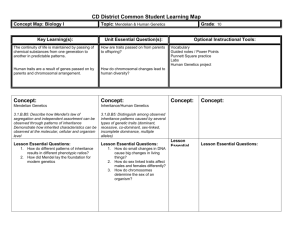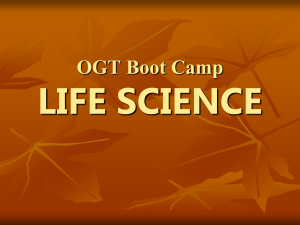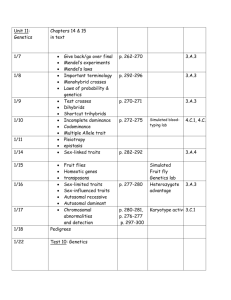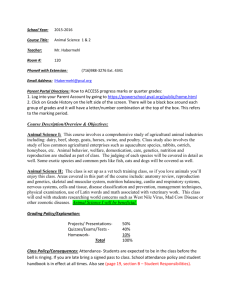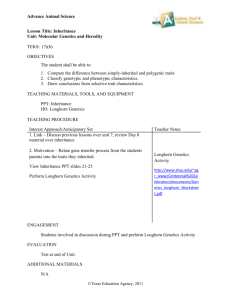UBD template 7.L.2 - the Essentially Science Wiki!
advertisement
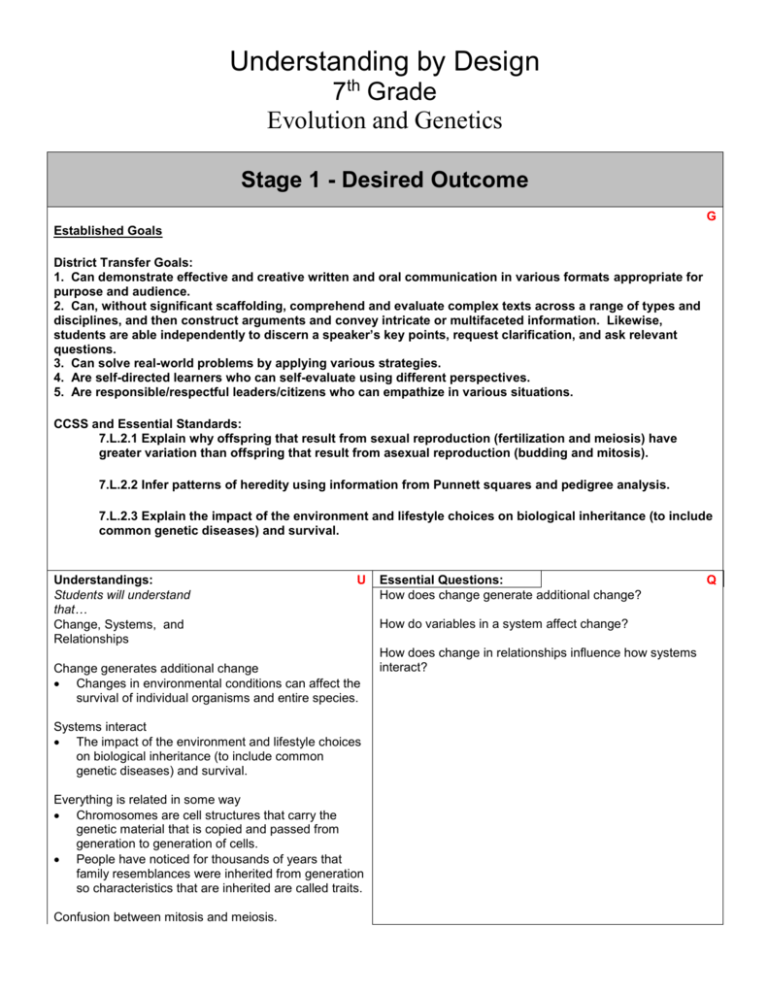
Understanding by Design 7th Grade Evolution and Genetics Stage 1 - Desired Outcome G Established Goals District Transfer Goals: 1. Can demonstrate effective and creative written and oral communication in various formats appropriate for purpose and audience. 2. Can, without significant scaffolding, comprehend and evaluate complex texts across a range of types and disciplines, and then construct arguments and convey intricate or multifaceted information. Likewise, students are able independently to discern a speaker’s key points, request clarification, and ask relevant questions. 3. Can solve real-world problems by applying various strategies. 4. Are self-directed learners who can self-evaluate using different perspectives. 5. Are responsible/respectful leaders/citizens who can empathize in various situations. CCSS and Essential Standards: 7.L.2.1 Explain why offspring that result from sexual reproduction (fertilization and meiosis) have greater variation than offspring that result from asexual reproduction (budding and mitosis). 7.L.2.2 Infer patterns of heredity using information from Punnett squares and pedigree analysis. 7.L.2.3 Explain the impact of the environment and lifestyle choices on biological inheritance (to include common genetic diseases) and survival. Understandings: Students will understand that… Change, Systems, and Relationships U Change generates additional change Changes in environmental conditions can affect the survival of individual organisms and entire species. Systems interact The impact of the environment and lifestyle choices on biological inheritance (to include common genetic diseases) and survival. Everything is related in some way Chromosomes are cell structures that carry the genetic material that is copied and passed from generation to generation of cells. People have noticed for thousands of years that family resemblances were inherited from generation so characteristics that are inherited are called traits. Confusion between mitosis and meiosis. Essential Questions: How does change generate additional change? How do variables in a system affect change? How does change in relationships influence how systems interact? Q Students will know . . . K Understanding the relationship of the mechanisms of cellular reproduction, patterns of inheritance and external factors to potential variation and survival among offspring. Explaining why offspring that result from sexual reproduction (fertilization and meiosis) have greater variation than offspring that result from asexual reproduction (budding and mitosis). Inferring patterns of heredity using information from Punnett squares and pedigree analysis. Explaining the impact of the environment and lifestyle choices on biological inheritance (to include common genetic diseases) and survival. All behavior is affected by both inheritance and experience. Students understand that new varieties of cultivated plants and domestic animals have resulted from selective breeding for particular traits Fish stick lab. Students will be able to S Define/identify change. Predict how movement generates change. Distinguish between positive, negative, both or neutral. Explain why change is inevitable. Stage 2 – Assessment Evidence Performance Tasks: T Sesame Street Genetics activity- Determining the genotypes of five Sesame Street characters, and map the known genes for one individual. Gummy Bear Genetics for simulating cross breeding. Dragon Genetics (biologica.concord.org) Web lab, then Dragon Genetics Lab – Principles of Mendelian Genetics – then Dragon Genetics (prezi.com) to link genetics to humans. Allele Frequencies and Sickle Cell Anemia Lab – To observe how selective forces can change allele frequencies in a population and cause evolution to occur. An Inventory of My Traits – Students take an inventory of their own easily- observable genetic traits. Toothpick Fish – Students will learn about the relationships between many different aspects of fish life: genes, traits, variation, survival, and reproduction. Write a RAFT from the point of view of Meiosis or either Mitosis. Students create a pedigree, a diagram of family relationships that uses symbols to represent people and lines to represent genetic relationships. Other Evidence: Pretests Posttests Labs Tic-Tac-Toe Graphs matching vocabulary Power point notes Worksheets self-check list Rubric Think-Pair-Share OE Use Punnett Square to predict genotypes and phenotypes of offspring. Demonstrate basic principles of Meiosis, fertilization, and inheritance using the same pea traits that Mendel studied (biologica.concord.org). Create a flip book on the stages of Meiosis and Mitosis. Compare and contrast Meiosis and Mitosis with double bubble thinking map. Create a Mitosis flip book. Complete Spongebob Genetics activity. Use studyjams.scholastic.com to study Heredity. Use plastic eggs and candy to determine traits (Easter Egg Genetics). Make a puppy using DNA. Map your traits on a gene wheel. Spell your name using DNA code. Use beans to simulate natural selection. Extract DNA from a Strawberry http://www.shsu.edu/~agr_www/documents/DNALA B.pdf http://www.gs.washington.edu/outreach/dhillon_dna procedure.pdf Monster Genetics: https://askabiologist.asu.edu/monster-manual Harry Potter Genetics: http://www.nlm.nih.gov/exhibition/harrypottersworld /education/lessonplans/science.html Gummy bear Genetics: http://www.nclark.net/gummybeargenetics.pdf Checklist, rubric L Learning Activities: W= Define the key vocabulary. Pretest. Compare and contrast meiosis and mitosis. H= What genes did you inherit from your parents? E= Students use Dragon Genetics to relate to Human Genetics. R = Students complete Dragon Genetics Web Lab and compare their findings with a partner. E = Self-evaluation. T = Group together for ESL, modifying assignment to the different needs of students O=
